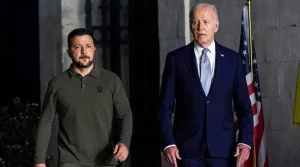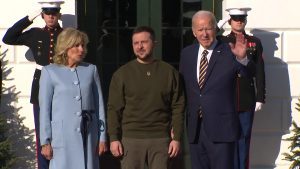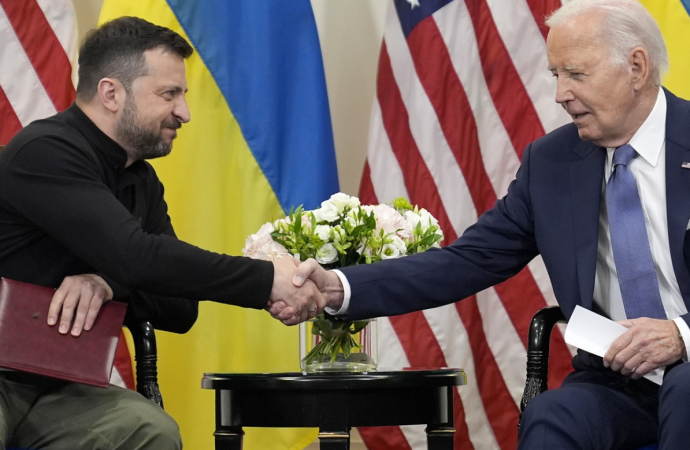In a significant show of solidarity against Russian aggression, President Joe Biden and Ukrainian President Volodymyr Zelenskyy finalized a pivotal 10-year bilateral security agreement during the BARI international summit. The agreement, bolstered by a multibillion-dollar loan aimed at fortifying Ukraine’s defense capabilities, marks a robust response to Russia’s invasion that has persisted for over two
In a significant show of solidarity against Russian aggression, President Joe Biden and Ukrainian President Volodymyr Zelenskyy finalized a pivotal 10-year bilateral security agreement during the BARI international summit. The agreement, bolstered by a multibillion-dollar loan aimed at fortifying Ukraine’s defense capabilities, marks a robust response to Russia’s invasion that has persisted for over two years.
Agreement Details and Financial Commitments

Image by : Yandex
At a joint news conference, President Biden emphasized the united front against what he termed “illegal aggression” by Russia. The bilateral security pact, coupled with a $50 billion loan supported by frozen Russian assets, underscores a resolute stance to support Ukraine’s military efforts, humanitarian needs, and post-conflict reconstruction.
Political Implications and U.S. Domestic Considerations
Despite the accord’s signing, its longevity could hinge on the outcome of the upcoming U.S. presidential election. Speculations suggest that a potential return of Donald Trump, known for his more conciliatory approach towards Russia during his tenure, might jeopardize continued U.S. support under the agreement. This uncertainty underscores the high-stakes political environment shaping international relations.
Retired Lt. Col. Alexander Vindman cautioned about potential volatility in U.S. foreign policy depending on electoral outcomes, highlighting a possible shift if a Democratic administration succeeds.
Path to NATO Membership and Strategic Alliances
President Zelenskyy characterized the security pact as a stepping stone towards eventual NATO membership, a longstanding strategic goal for Ukraine. However, Biden reiterated that Ukraine’s accession into NATO would not be imminent amidst ongoing conflict with Russia.
Economic and Diplomatic Strategies
The $50 billion loan, announced at the G7 summit, signifies a collective effort by advanced industrial democracies to alleviate Ukraine’s financial burdens in the face of prolonged conflict. The loan’s structure, secured by interest from frozen Russian assets, underscores a punitive economic strategy to compel Russia towards resolution.
International Diplomacy and Global Repercussions
Western allies, committed to isolating Russia through sanctions and diplomatic initiatives, seek to curtail external support to Russian forces. President Zelenskyy’s assertion regarding China’s non-participation in arms sales to Russia reflects broader efforts to limit international assistance to Russia’s military operations.
Biden’s International Engagement

Image by : Yandex
President Biden’s participation at the BARI summit, encompassing discussions beyond Ukraine. But the global infrastructure and challenges posed by China’s economic policies, underscores a comprehensive approach to international diplomacy. His meetings, including a notable engagement with Pope Francis on artificial intelligence risks, highlight a broad diplomatic agenda amidst personal and political challenges back in the United States.
Reinforcing U.S. Credibility
In the wake of delays and debates over past aid packages, the new pact restores U.S. credibility in two key ways:
- Strategic Clarity: A decade-long agreement sets clear expectations and funding frameworks, avoiding year-to-year uncertainty.
- Bipartisan Guardrails: By formalizing commitments in a written pact, the U.S. limits the ability of any single administration to abruptly withdraw critical support.
This credibility boost not only matters for Ukraine but also reassures other allies—from Taiwan to the Baltic states—that U.S. security guarantees are reliable.
Impact on Russian Strategy
For Moscow, the agreement poses a strategic challenge:
- Costly Calculus: Any renewed invasion now risks a more prepared and well-equipped Ukrainian defense, backed by U.S. resources.
- Diplomatic Isolation: As the U.S. locks in support, Russia finds it harder to negotiate a quick settlement or peel away Western unity.
- Escalation Risks: Desperate measures—cyberattacks, sabotage, or wider proxy conflicts—may rise if conventional options prove too risky.
In effect, the pact raises the threshold for Russian aggression by promising onward support and making a quick victory less likely.
Broader Global Security Implications
Middle East and Asia Pacific
Commitments in Europe free the U.S. to address other hotspots. A secure eastern flank allows Washington to focus on challenges in the Middle East and deter China’s ambitions in the Asia-Pacific region, where allies closely watch U.S. resolve.
Defense Industry and Innovation
Long-term aid plans enable U.S. defense firms to ramp up production and R&D with more confidence. Supply chains for air defenses, artillery, and drones can scale without the stop-start cycles of short-term funding.
Multilateral Cooperation
The agreement spurs broader coalition efforts. European partners have already pledged billions in military and financial aid. The pact’s clarity encourages them to maintain or expand their own commitments alongside U.S. support.
Challenges and Considerations
No agreement is without risks:
- Domestic Politics: A future U.S. administration could seek to renegotiate or exit, testing the pact’s legal and political durability.
- Escalation Dynamics: Russia may respond by heightening hybrid threats—cyberwarfare, disinformation, and energy blackmail.
- Reconstruction vs. Defense Balance: As the war drags on, balancing funds between immediate military needs and long-term rebuilding will be vital.
Success hinges on sustained political will, transparent oversight of aid, and ongoing adaptation to shifting battlefield realities.
Looking Ahead: Shaping a “Just Peace”
The pact’s final clause—shared vision of a “just peace”—points toward post-conflict stability:
- Rebuilding Security Institutions: Joint programs could reform Ukrainian defense, align training with NATO, and modernize command structures.
- Economic Recovery: Coordinated aid can rebuild infrastructure and address humanitarian needs, preventing future instability.
- Regional Security Architecture: A formalized Ukraine-U.S. partnership may serve as a template for similar agreements in other conflict zones, fostering global norms of shared defense.
By linking military support with broader political and economic goals, the agreement aims not just to end the war but to secure lasting stability.
Conclusion
As President Biden’s visit to Italy concludes, the signed security agreement. Between the U.S. and Ukraine stands as a pivotal commitment amidst ongoing geopolitical tensions. But the agreement’s future remains intertwined with global political dynamics, underscoring the critical role. And the international cooperation in addressing regional conflicts and safeguarding global stability.
















